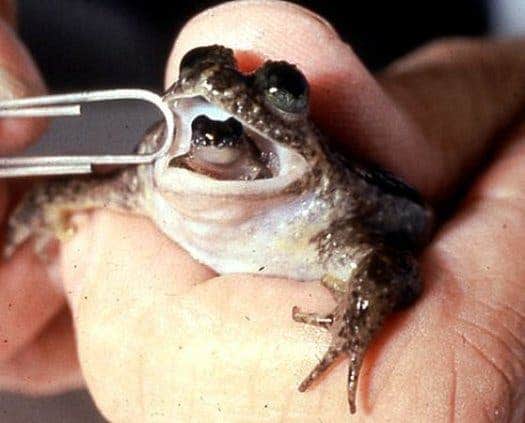
The gastric brooding frog incubates and hatches its eggs in its gut. The hatchlings then exit through the frog’s mouth. (c) Australian Government Department of the Environment, Water, Heritage and the Arts
In a great leap forward towards reviving extinct animal species, scientists at University of New South Wales, Australia have grown embryos that contain the genetic markup of a rather peculiar, yet unfortunately extinct frog species native to Australia. The frog died off in the 1980s due to parasites, loss of habitat, invasive weeds and fungus, and was one of the few animals known in the world to give birth through its mouth.
Birth through its mouth? Well, we’ve heard of weirder uses of the oral cavity, like urinating, but the gastric-brooding frog’s breeding trick is quite nifty. When this frog used to lay eggs, these were coated in a substance called prostaglandin, which breaks off the gastric acid in the stomach, making it a hospitable place for just about anything, including eggs. Naturally, the frog swallows these eggs, incubates them directly in the gut and when they hatch, the little baby frogs crawl out through the mouth.
Alas, both subspecies of frog – the the northern and souther gastric-brooding frog – went extinct sometime in the mid ’80s, yet genetics is not keen of farewells. Aptly named the Lazarus project, scientists have inserted dead genetic material of the extinct amphibian (conveniently, frozen specimens were kept in a common household freezer) into the donor eggs of another related species of living frog – the great barred frog, which also lives in Queensland.
“In the beginning, the single cell eggs just sat there. But then, all of a sudden, one of the cells divided, and then it divided again, and again,” said University of NSW palaeontologist Mike Archer.
“There were a lot of high fives around the laboratory at that point.”
Resurrecting the extinct back to life
The eggs continued to grow into three-day-old embryos, which scientists refer to as blastulas. They didn’t survive afterwards, unfortunately, it was confirmed however that these embryos contain genetic information from the gastric-brooding frog. Still, their findings mark a big step forward in research efforts directed towards riving extinct animals. The Newcastle researchers are confident that this is a purely technical, not biological problem and in future attempts they’ll be able to breed a gastric-brooding frog to adulthood.
“This is the first time this technique has been achieved for an extinct species,” conservation biologist Michael Mahony told the Sydney Morning Herald.
The researchers hope that someday they’ll be able to revive a slew of currently extinct species – a flicker of hope that humanity’s monstrous mistakes might be mended – such as the woolly mammoth, dodo, Cuban red macaw and New Zealand’s giant moa.
“We are watching Lazarus arise from the dead, step by exciting step,” says the leader of the Lazarus Project team, Professor Mike Archer, of the University of New South Wales, Sydney. “We’ve reactivated dead cells into living ones and revived the extinct frog’s genome in the process. Now we have fresh cryo-preserved cells of the extinct frog to use in future cloning experiments.
“We’re increasingly confident that the hurdles ahead are technological and not biological and that we will succeed. Importantly, we’ve demonstrated already the great promise this technology has as a conservation tool when hundreds of the world’s amphibian species are in catastrophic decline.”
Professor Archer spoke last week at the TEDx DeExtinction event when the Lazarus Project was publicly discussed for the first time. Archer also expressed his ongoing interest in cloning the extinct Tasmanian tiger, which died off almost a century ago.









